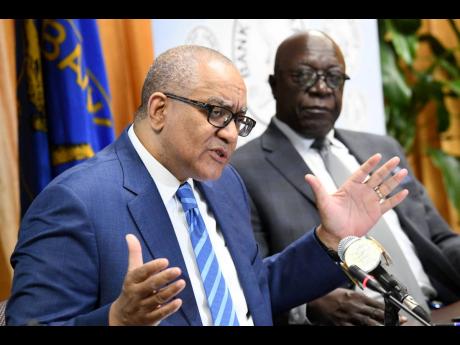BOJ cuts interest rate to 0.75% as stimulus - Private-sector credit growing, but not enough to satisfy Governor Wynter
Credit extended to private-sector businesses and households grew by 15.2 per cent over the 12 months to March 2019, higher than the 13.4 per cent observed at December 2018 and the 13.8 per cent at March 2018.
However, Bank of Jamaica (BOJ) Governor Brian Wynter says that while the pace of credit expansion has accelerated since he hosted a briefing in February this year and such a sign was encouraging, it was still not fast enough.
“Based on the estimates of the capacity of the economy, faster growth is possible without causing inflation to rise above the inflation target,” said Wynter at his quarterly briefing at the central bank in Kingston on Tuesday.
On Monday, the BOJ cut its policy rate – the rate offered on overnight placements with the BOJ – by 50 basis points to 0.75 per cent.
The decision reflects the bank’s forecast that, even though headline inflation will increase to an average 4.5 per cent over the next two years, there will be months when it will fall below the lower limit of the target of 4.0 to 6.0 per cent.
In addition, the Governor said, notwithstanding the uptick in annual inflation, core or underlying inflation is projected to remain low.
Wynter said that in the period that follows, headline inflation is forecast to approach the midpoint of the target gradually “but, and this is important, at a slower pace than we had expected at the last assessment in February this year”.
The governor said the policy-rate cut is aimed at increasing the pace of expansion in private-sector credit, which will stimulate increased economic activity on the part of businesses and households.
“We have made this point many times in the past, and I want to emphasise it today as it is very important that the public fully appreciates that this is the sole purpose of our action,” Wynter said.
“The increased economic activity by businesses and households will bring with it a bit more inflation, and, in that way, the rate cut will support inflation returning to the centre of the target more quickly,” the governor added.
The central bank also announced a reduction in the cash reserve requirement by two percentage points to seven per cent, effective June 3, which Wynter said will increase liquidity in the financial system by $12.3 billion, thereby supporting the provision of more credit to businesses and households at lower rates and on better terms.
The BOJ also reduced the width of the interest-rate corridor from 300 to 200 basis points in order to strengthen the effect of changes in the policy rate on the interest rates the public pays when they borrow from banks and other financial institutions and interest rates they receive on their deposits and other investments.
The interest-rate corridor is the difference between the policy rate and the standard interest rate on the overnight liquidity facility, the latter used by the BOJ to provide overnight advances on demand to banks, merchant banks and building societies.
The reduction in the width of the interest-rate corridor will result in a reduction in the standard interest rate to 2.75 per cent per annum, that is, the policy rate of 0.75 per cent per annum plus 200 basis points.
Wynter noted that the BOJ also announced last week additional liquidity operations aimed at encouraging faster expansion in credit and increasing the availability of assets that qualify as liquid assets for banks, merchant banks and building societies.
“These operations, in combination with the bank’s regular liquidity operations, will assist in smoothing the impact on system liquidity of the Government repaying $40.5 billion to investors on the maturity date of a government bond in July 2019,” the governor said.
The decision to lower the policy rate was informed by the latest data released by the Statistical Institute of Jamaica, which showed that inflation for April 2019 was 3.9 per cent, up from 3.4 per cent at March 2019 and 3.2 per cent at April 2018.
Noting that inflation has been picking up, Wynter said that mainly reflected the impact of some normalisation in the prices of agricultural food items, particularly vegetables and some processed foods, partly offset by a decline in electricity rates.
At the same time, he said, inflation remained below the target for the fifth consecutive month, and underlying inflation remained low.
The BOJ is forecasting that headline inflation will rise towards 5.0 per cent, the mid-range of the target by the March 2020 quarter, as domestic agricultural prices increase from the low levels of recent months to more normal levels and domestic economic activity increases in response to the lowering of the policy rate over the last two years.
However, “we do not expect inflation to stay at the midpoint of the target”, Wynter said. “Rather, we expect that inflation will decline towards the bottom of the target in the quarters after March 2020 and only return to the midpoint slowly over the ensuing three years.”

